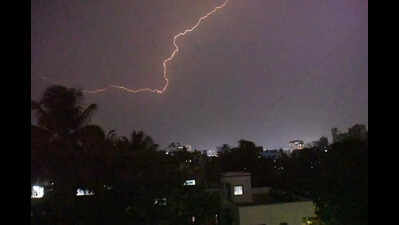- News
- Bihar among major lightning hotspots
Bihar among major lightning hotspots
Patna: Among the many natural forces that shape our world, none is as swift, spectacular or terrifying as lightning. A singular streak of brilliance across the sky, followed by the deafening boom of thunder – it is the most dramatic of nature's performances. Yet beneath its beauty lies a brutal truth – lightning remains one of the deadliest geophysical phenomena on Earth.
Each year, it claims hundreds of thousands of lives worldwide. In India, the toll is staggering. According to the National Disaster Management Authority (NDMA), thunderstorms accompanied by lightning are the single-largest killers among natural disasters in the country, especially during the pre-monsoon and monsoon months.
Data from the India Meteorological Department (IMD) reveals a grim consistency. Since 2004, at least 2,000 Indians have died every year from lightning strikes.
"Lightning is more than just a flash in the sky," said Dr Ashok Kumar Jha, a physicist at Patna University. "There are approximately 30 to 100 cloud-to-cloud or cloud-to-ground lightning discharges per second across the globe. That amounts to about 9 million discharges every single day," he added.
Dr Jha also pointed out a lesser-known but critical fact – about 90% of lightning strikes occur over land. "That's because land heats faster under the sun than water, fuelling taller and more intense thunderstorms. Central and eastern India, including Bihar, Jharkhand, Odisha, West Bengal and parts of Bangladesh, are major lightning hotspots. The period from March until the arrival of the monsoon is the most dangerous," he added.
In Bihar, the sky's fury has become a recurring nightmare. Ramesh Shukla, former head of the geology department at Patna University, said the state witnesses between 150 to 400 lightning-related deaths annually.
"Field surveys have shown that many fatalities occur when people seek shelter from the rain under large, isolated trees, ironically placing themselves directly in harm's way. Thanks to a vast network of ground- and space-based meteorological observations, we are now able to pinpoint potential thunderstorm zones," Shukla said.
To keep people informed, mobile applications like the ministry of earth sciences' ‘Damini' and the Bihar govt's ‘Indra Vajra' are now offering free lightning alerts. These digital tools are saving lives.
But experts warn that the lightning menace is far from a passing phase. It is, instead, intensifying.
Ashok Kumar Ghosh, former chairman of the Bihar State Pollution Control Board and a noted environmentalist, sees the fingerprints of climate change all over this surge.
"The recent spike in lightning strikes can certainly be linked to the climate crisis. Climate change is expected to increase both the frequency and severity of thunderstorms, owing to rising surface temperatures and greater atmospheric moisture," he said.
Ghosh added, "Both temperature and moisture have increased in recent years. Urbanisation, which contributes to the loss of tree cover, also leads to elevated ground temperatures. If these trends continue, lightning deaths will only rise in the years to come."
End of Article
Follow Us On Social Media











